The war drones on. The days of the world cruise are for the time being a memory, and disappear from the screen. Railway travel becomes restricted to allow for transport of troops (prompting Bugs Bunny to cut short a neat escape on a locomotive in The Unruly Hare as he recalls, “I almost forgot. None of us civilians should be doin’ any unnecessary traveling these days.”) Even the air appears largely reserved for the likes of fighter pilots and dive bombers. But nothing stops a hearty toon from occasionally answering the call of the wild to “rough it” in the great outdoors, or, where appropriate in doing their bit for the Allied effort, from promoting the Good Neighbor Policy by restricting their extended vacations to the neighboring Americas.
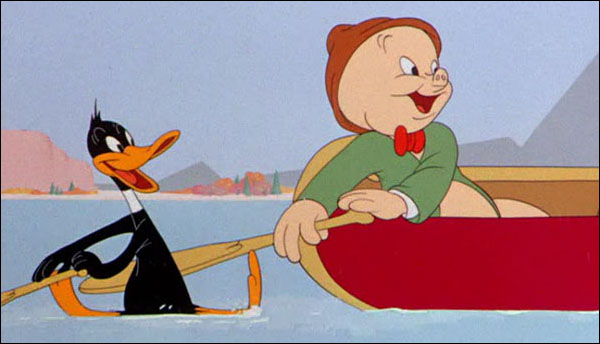
My Favorite Duck (Warner, Looney Tunes (Porky Pig, Daffy Duck), 12/5/42 – Charles M. (Chuck) Jones, dir.) – In their first appearance together in Technicolor. Porky and Daffy have a field day – afield in the great outdoors. Porky paddles a canoe over a scenic lake, crooning the stuttering refrain of “On Moonlight Bay”. Daffy (in his classic screwball mode, ready to heckle just for the heck of it), appears from underwater to join in the serenade in close harmony – no boat, but he simply spreads his webbed feet to simulate the shape of a canoe. When Porky realizes he has unexpected company, Daffy disappears down the lake in a “woo woo” frenzy. “G-Gosh, what a cr-cr–screwy duck”, comments Porky. Reappearing in the canoe, Daffy replies, “That, my little cherub, is strictly a matter of opinion”, as his eyes bulge out to almost fill Porky’s sockets.
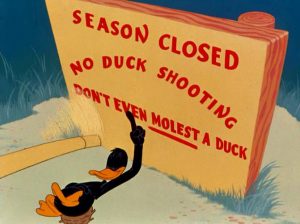 Porky attempts to pitch his tent, but everywhere he tries to drive a stake, finds Daffy lounging on the ground, blocking his way. He is about to use the stake to inflict some bodily harm, when Daffy confronts him with a sign reading “Season Closed – No Duck Shooting. Don’t even molest a duck.” “Catch on, fatso?”, Daffy quips, establishing his running advantage to be revisited throught the film. Porky continues to find no open ground from the duck blocking his way, and finally pitches the tent in the only open place he can find – underwater in the lake bed. Breakfast is no snap either – as Daffy pulls an egg switch, replacing Porky’s chicken egg with a huge one. “Nothing like this mountain air to make things grow”, gullible Porky surmises. On cracking it open, a baby eagle is revealed – and Papa is right there to let Porky have it in the face with his own frying pan, while Junior, in a non-stop flurry of questions, asks if they’ll have to bury the man and if he has rigor mortis. Daffy flaunts signs warning of a $500 fine for duck harming every time Porky loses his cool. Daffy continues to pull cruel tricks on Porky, like turning his canoe upside down while he sleeps, then yanking on Porky’s fishing line, causing Porky to dive into – the sky, in attempt to retrieve his lost pole. Or giving Porky two sticks to rub together to start a fire, which just happen to be sticks of dynamite. In an odd and creative idea, Porky’s whole campsite is blown sky-high – and somehow hovers in mid-air until the bottom falls out from under Porky alone, sending him crashing to Earth.
Porky attempts to pitch his tent, but everywhere he tries to drive a stake, finds Daffy lounging on the ground, blocking his way. He is about to use the stake to inflict some bodily harm, when Daffy confronts him with a sign reading “Season Closed – No Duck Shooting. Don’t even molest a duck.” “Catch on, fatso?”, Daffy quips, establishing his running advantage to be revisited throught the film. Porky continues to find no open ground from the duck blocking his way, and finally pitches the tent in the only open place he can find – underwater in the lake bed. Breakfast is no snap either – as Daffy pulls an egg switch, replacing Porky’s chicken egg with a huge one. “Nothing like this mountain air to make things grow”, gullible Porky surmises. On cracking it open, a baby eagle is revealed – and Papa is right there to let Porky have it in the face with his own frying pan, while Junior, in a non-stop flurry of questions, asks if they’ll have to bury the man and if he has rigor mortis. Daffy flaunts signs warning of a $500 fine for duck harming every time Porky loses his cool. Daffy continues to pull cruel tricks on Porky, like turning his canoe upside down while he sleeps, then yanking on Porky’s fishing line, causing Porky to dive into – the sky, in attempt to retrieve his lost pole. Or giving Porky two sticks to rub together to start a fire, which just happen to be sticks of dynamite. In an odd and creative idea, Porky’s whole campsite is blown sky-high – and somehow hovers in mid-air until the bottom falls out from under Porky alone, sending him crashing to Earth.
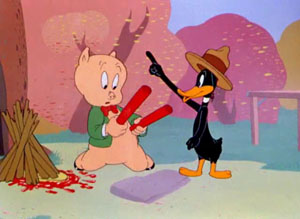 Porky literally “burns up” into flames and a puff of smoke, then reassembles his atoms, saying “Oooh, if I just had a shotgun” Obliging Daffy hands him one, saying, “Okay, Annie Oakley, here y’are – but it ain’t gonna do you any good!” He pulls as if a window curtain another sign down from a tree, which we all expect to have the usual warning. But something new has been added, as the signage has been uupdated, now reading “Duck Season Opens Today.” An amazed Porky brightens with glee, and sets himself to the task at hand. Daffy, now getting a glimpse of the sign, starts backing up cautiously, hoping for a change in his fortunes. He zips behind a bush, producing another sign he hopes will have a better message. Better it is – for Porky, not for him, as the new sign reads, “No Limit! Shoot all you want.” Daffy tries again, and gets another sign reading “$500 reward for shooting a duck.” He hides behind a billboard, only to find the sign displays a large arrow pointing directly at him, and the words “Shoot a duck today. Especially this duck.” With all the odds stacked against him, Daffy holds up a white flag. A shot from Porky’s rifle perforates the flag with buckshot holes, forming the letters, “Start praying duck.” All that’s left to do is run, which Daffy does to a high peak with a lone pine tree atop. He circles the tree as Porky gives chase close behind, round and round and round – and suddenly, the film snaps, as if broken in the projection booth. The screen goes blank – until Daffy peers out at us from the theatre wings. He walks to center stage, apologizing for the technical difficulty, but offers to satisfy the audience’s curiosity by telling them how the picture came out. He concocts a tale of how he launced a “counterattack”, showered Porky with lefts and rights, and had Porky “crawling – literally groveling at my feet…” From behind him in the wings rises an old-time stage “hook” from the days of vaudeville, and yanks Daffy back into the wings, where a loud crash is heard. Porky Pig crosses the stage, his rifle barrel bent to a shape assumed from a hard impact upon Daffy’s head, dragging the stupefied Daffy, who continues to mumble, “He’s pleadin’ for mercy. I’m killin’ ‘im.”
Porky literally “burns up” into flames and a puff of smoke, then reassembles his atoms, saying “Oooh, if I just had a shotgun” Obliging Daffy hands him one, saying, “Okay, Annie Oakley, here y’are – but it ain’t gonna do you any good!” He pulls as if a window curtain another sign down from a tree, which we all expect to have the usual warning. But something new has been added, as the signage has been uupdated, now reading “Duck Season Opens Today.” An amazed Porky brightens with glee, and sets himself to the task at hand. Daffy, now getting a glimpse of the sign, starts backing up cautiously, hoping for a change in his fortunes. He zips behind a bush, producing another sign he hopes will have a better message. Better it is – for Porky, not for him, as the new sign reads, “No Limit! Shoot all you want.” Daffy tries again, and gets another sign reading “$500 reward for shooting a duck.” He hides behind a billboard, only to find the sign displays a large arrow pointing directly at him, and the words “Shoot a duck today. Especially this duck.” With all the odds stacked against him, Daffy holds up a white flag. A shot from Porky’s rifle perforates the flag with buckshot holes, forming the letters, “Start praying duck.” All that’s left to do is run, which Daffy does to a high peak with a lone pine tree atop. He circles the tree as Porky gives chase close behind, round and round and round – and suddenly, the film snaps, as if broken in the projection booth. The screen goes blank – until Daffy peers out at us from the theatre wings. He walks to center stage, apologizing for the technical difficulty, but offers to satisfy the audience’s curiosity by telling them how the picture came out. He concocts a tale of how he launced a “counterattack”, showered Porky with lefts and rights, and had Porky “crawling – literally groveling at my feet…” From behind him in the wings rises an old-time stage “hook” from the days of vaudeville, and yanks Daffy back into the wings, where a loud crash is heard. Porky Pig crosses the stage, his rifle barrel bent to a shape assumed from a hard impact upon Daffy’s head, dragging the stupefied Daffy, who continues to mumble, “He’s pleadin’ for mercy. I’m killin’ ‘im.”
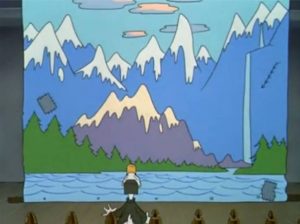 Der Fuehrer’s Face (Disney/RKO, Donald Duck, 1/1/43 – Jack Kinney, dir.), recently the subject of an article on this website in its own right, features a sequence not mentioned in said article, providing Donald with the shortest vacation in history. Donald is a munitions worker in Nazi Germany (yes, of course it’s a dream), performing chores on the assembly line at bayonet point, twisting on the firing caps upon an endless array of bombs of every size. After a typically grueling day, an announcement comes over the loudspeaker system, “Now comes the vacation – mit pay.” A large theatrical backdrop unrolls from the ceiling behind Donald, depicting an image of the Alps, for Donald to enjoy the beautiful scenery, while still remembering to keep fit for Der Fuehrer, as he is drilled through a series of calisthenics causing him to repeatedly assume the shape of a swastika. Just as suddenly, the backdrop is removed, as the announcer not only informd him that the vacation is over, but adds that by special decree of Der Fuehrer, Donald has been chosen to work overtime!
Der Fuehrer’s Face (Disney/RKO, Donald Duck, 1/1/43 – Jack Kinney, dir.), recently the subject of an article on this website in its own right, features a sequence not mentioned in said article, providing Donald with the shortest vacation in history. Donald is a munitions worker in Nazi Germany (yes, of course it’s a dream), performing chores on the assembly line at bayonet point, twisting on the firing caps upon an endless array of bombs of every size. After a typically grueling day, an announcement comes over the loudspeaker system, “Now comes the vacation – mit pay.” A large theatrical backdrop unrolls from the ceiling behind Donald, depicting an image of the Alps, for Donald to enjoy the beautiful scenery, while still remembering to keep fit for Der Fuehrer, as he is drilled through a series of calisthenics causing him to repeatedly assume the shape of a swastika. Just as suddenly, the backdrop is removed, as the announcer not only informd him that the vacation is over, but adds that by special decree of Der Fuehrer, Donald has been chosen to work overtime!
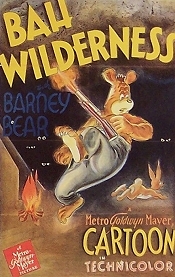 Bah Wilderness (MGM, Barney Bear, 2/13/43 – Rudolf Ising, dir.) – On a seemingly peaceful evening, Barney Bear sets up campsite in the deep woods, prepared for an evening of comfort with his new “Snuggly Wuggly” inflatable air mattress. After blowing it up, Barney tries to remove his trousers to slip into a nightshirt. A sea of eyes in the darkness find him overcome with em-bear-assment, and an aim of a flashlight into the darkness reveals an audience of deer, squirrels, raccoons, etc. Barney tosses his flashlight at them and they scatter. But one chipmunk lags behind, and turns on the flashlight to spotlight Barney just as his striped shorts are showing. Barney smashes the flashlight with a thrown rock. A wide-eyed baby owl, and a coyote’s wails, further spook Barney, but he finally makes it into his nightshirt. However, a porcupine has crawled into his bedding, and Barney encounters it – from the rear. Leaving a comet’s trail in his wake, Barney finds himself at the top of the tallest pine, while the porcupine finds his rear half denuded of quills. On his way out, the porcupine almost stumbles into a bear trap packed in Barney’s supplies. (Now why would a bear be hunting bear? Is there an untold romantic angle here, with Barney possibly ‘hunting’ for a mate?) Barney realizes he’s brought along a whole array of traps, ranking in size right down to the common mousetrap. To guarantee his peace, he encircles his camp with them, then finally settles into bed (with reuse for the umpteenth time of old animation from The Bear Who Couldn’t Sleep (1939)). The chipmunk reappears, and stumbles over a transistor radio Barney has packed, turning it on to a station playing loud symphony music. To make matters worse, he attempts to scamper away, spinning the volume control on which he stands to full blast. Barney rises and steps forward to stop the music – forgetting entirely his array of traps, which ensnarl him from nose to toes.
Bah Wilderness (MGM, Barney Bear, 2/13/43 – Rudolf Ising, dir.) – On a seemingly peaceful evening, Barney Bear sets up campsite in the deep woods, prepared for an evening of comfort with his new “Snuggly Wuggly” inflatable air mattress. After blowing it up, Barney tries to remove his trousers to slip into a nightshirt. A sea of eyes in the darkness find him overcome with em-bear-assment, and an aim of a flashlight into the darkness reveals an audience of deer, squirrels, raccoons, etc. Barney tosses his flashlight at them and they scatter. But one chipmunk lags behind, and turns on the flashlight to spotlight Barney just as his striped shorts are showing. Barney smashes the flashlight with a thrown rock. A wide-eyed baby owl, and a coyote’s wails, further spook Barney, but he finally makes it into his nightshirt. However, a porcupine has crawled into his bedding, and Barney encounters it – from the rear. Leaving a comet’s trail in his wake, Barney finds himself at the top of the tallest pine, while the porcupine finds his rear half denuded of quills. On his way out, the porcupine almost stumbles into a bear trap packed in Barney’s supplies. (Now why would a bear be hunting bear? Is there an untold romantic angle here, with Barney possibly ‘hunting’ for a mate?) Barney realizes he’s brought along a whole array of traps, ranking in size right down to the common mousetrap. To guarantee his peace, he encircles his camp with them, then finally settles into bed (with reuse for the umpteenth time of old animation from The Bear Who Couldn’t Sleep (1939)). The chipmunk reappears, and stumbles over a transistor radio Barney has packed, turning it on to a station playing loud symphony music. To make matters worse, he attempts to scamper away, spinning the volume control on which he stands to full blast. Barney rises and steps forward to stop the music – forgetting entirely his array of traps, which ensnarl him from nose to toes.
A series of camera wipes denotes the passage of time to 1:00 a.m., as the radio changes programs to a performance by their “lullaby lady’. Barney has escaped the traps, bit still can’t sleep with the moon in his eyes as it “comes over the mountain” to Kate Smith’s song. Finally the strains of Emmett’s Lullaby “(Go To Sleep My Baby) do the trick, while the radio broadcast signs off. A bear’s snoring is of powerful nature, and the sleeping Barney sucks into his mouth the end of the inflating tube of the air mattress. With every exhale, the mattress grows bigger and bigger – rising to the roost of the owl in the tree, and causing all the animals to run for safer ground. As the inflation tube itself expands into a mini-balloon, Barney’s eyes pop open just in time for the whole shebang to explode in his face. In a cartoon, things can always get worse – and they do. Drops of rain hit Barney in the face, and a lightning bolt above opens the clouds with a zipper for a flash flood. The entire campsite is deluged, and Barney soon funds himself in a forest submerged under six feet of water. Now things can’t get any worse, and Barney demonstrates his hidden amphibious talents, merely pulling up the blankets over him, and falling asleep again, as the flood waters placidly flow over him. Anyone for a slightly damp bearskin rug?
The film isn’t online anywhere – except on Facebook.
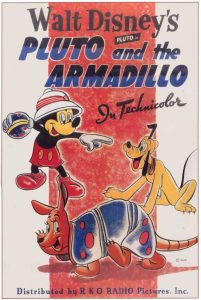 Pluto and the Armadillo (Disney/RKO, Mickey Mouse, 2/19/43 – Clyde Geronimi, dir.) – Rumored to have been intended as an element of Saludos Amigos, but not completed in time for the feature’s release. A quite simple premise to fill the allotted seven minutes A Brazilian jungle armadillo is a dead ringer when rolled up for Pluto’s rubber ball, and mistaken identity ensues. Mickey and Pluto arrive on tour in Belem, Brazil, on the fringe of the Amazon, by way of an airline which oddly gets a free plug by name in the cartoon (the plane insignia reading PAA – or Pan American Airlines, for those who remember). Mickey tosses the rubber ball for Pluto to fetch during a stopover, but it bounces into the jungle, colliding with the armadillo, who instantly rolls up into a defensive ball, while the real ball rolls behind a bush. Pluto tries to pick up the “ball” – but it moves out of reach! Frustrated Pluto tries again and again, but just can’t sink his teeth into the situation. The armadillo rolls into the bushes, and rolls back pushing the real rubber ball. Pluto is more perplexed than ever at seeing double, and spends a good deal of time in analysis of the situation and in trying to keep the two balls together, before he fully realizes that something’s fishy about the one that keeps sprouting a head and tail from time to time. But the armadillo is friendly, and keeps giving Pluto coy winks, raising Pluto’s curiosity. The two get into a game of subterranean follow-the-leader, Pluto following the creature into an underground tunnel as fast as the armadillo can dig it. But the armadillo takes a detour around a large shrub in the ground, while Pluto smashes straight into it, coming up with the plant-life on his head, resembling a Carmen Miranda tutti-fruitti hat.
Pluto and the Armadillo (Disney/RKO, Mickey Mouse, 2/19/43 – Clyde Geronimi, dir.) – Rumored to have been intended as an element of Saludos Amigos, but not completed in time for the feature’s release. A quite simple premise to fill the allotted seven minutes A Brazilian jungle armadillo is a dead ringer when rolled up for Pluto’s rubber ball, and mistaken identity ensues. Mickey and Pluto arrive on tour in Belem, Brazil, on the fringe of the Amazon, by way of an airline which oddly gets a free plug by name in the cartoon (the plane insignia reading PAA – or Pan American Airlines, for those who remember). Mickey tosses the rubber ball for Pluto to fetch during a stopover, but it bounces into the jungle, colliding with the armadillo, who instantly rolls up into a defensive ball, while the real ball rolls behind a bush. Pluto tries to pick up the “ball” – but it moves out of reach! Frustrated Pluto tries again and again, but just can’t sink his teeth into the situation. The armadillo rolls into the bushes, and rolls back pushing the real rubber ball. Pluto is more perplexed than ever at seeing double, and spends a good deal of time in analysis of the situation and in trying to keep the two balls together, before he fully realizes that something’s fishy about the one that keeps sprouting a head and tail from time to time. But the armadillo is friendly, and keeps giving Pluto coy winks, raising Pluto’s curiosity. The two get into a game of subterranean follow-the-leader, Pluto following the creature into an underground tunnel as fast as the armadillo can dig it. But the armadillo takes a detour around a large shrub in the ground, while Pluto smashes straight into it, coming up with the plant-life on his head, resembling a Carmen Miranda tutti-fruitti hat.
The armadillo laughs, and Pluto gets riled. He gives chase above ground, and the armadillo rolls into a ball again and into another tunnel, passing the rubber ball resting outside. Pluto skids into the scene and grabs the only ball he can see, thinking he’s caught the critter at last. He violently shakes and stretches the sphere in his jaws – and suddenly hears a loud “POP”. Below him are shreds of the outer shell – and no little creature. Pluto imagines the worst, and sees vision of the armadillo wearing angel wings. Believing he’s committed homicide, Pluto weeps bitterly, producing a puddle of tears – until the real armadillo, hearing his sobs, gives him a slurp on the face to cheer him up. With delayed reaction, Pluto becomes overjoyed to find all is well, and joins in a celebration dance with his new pal, bouncing and rolling himself into a ball to match his friend’s dance moves. Back at the airfield, a final call for passenger boarding is sounded. Mickey races into the jungle to find Pluto, startling the armadillo into a ball again. Mickey is fooled too, and scoops up the “ball” and Pluto, carrying them back to the aircraft. The flight takes off, and inside, Mickey is as surprised as Pluto was to see the armadillo’s head pop out and exchange another wink and kiss with Pluto. A film that goes more for charm than belly-laughs, with quality backgrounds and a catchy South American music score by Disney house musician Paul Smith (who composed the entire score, including “The Armadillo Samba,” which was published separately as a song, with lyrics).
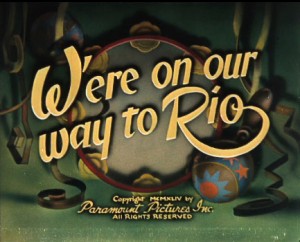 We’re On Our Way To Rio (Paramount/Famous, Popeye, 4/21/44 – I. Sparber, dir.), has been written about several times on this website, not only for its anumation, but for its musical score on the “Needle Drop Notes” columns of James Parten. A partial reworking of “Kickin’ the Conga Round”, the film presents one of the most lavish Technicolor settings in which Popeye ever brawled, sterling voice work (including a genuine Latina voice for the Olive look-alike), an imaginative night club setting with stage decor themed around a giant rotating tambourine, periodic flashes of eccentric Jim Tyer animation, and some smooth as silk dancework with liberal use of Fleischer’s rotoscope. This being the studio’s only Technicolor all-out effort for the good neighbor policy, the budget must have been increased on a parity with some of the Superman series to account for the quality of the artwork. Winston Sharples also gets his own at bats, not only adapting an established Samba for Olive, but taking a leaf from the studio’s famous “Road” pictures for Bing and Bob by writing Popeye and Bluto an introductory title song that reminds one of opening numbers like “Road to Morocco”, to complete the atmosphere. Of course, as in its predecessor film, Popeye knows from nothing about “Sambo” dancing, and is barely able to perform a hornpipe, until spinach provides him with the rhythm. His arms transform into maracas for self-accompaniment, as he wows the crowd and pows Bluto. His final twirls with Olive set them into a whirlwind, from which they both emerge wearing each other’s clothes. (I’m surprised the censors didn’t flinch at the suggestion of those few intimate moments that must have taken place inside the vortex!)
We’re On Our Way To Rio (Paramount/Famous, Popeye, 4/21/44 – I. Sparber, dir.), has been written about several times on this website, not only for its anumation, but for its musical score on the “Needle Drop Notes” columns of James Parten. A partial reworking of “Kickin’ the Conga Round”, the film presents one of the most lavish Technicolor settings in which Popeye ever brawled, sterling voice work (including a genuine Latina voice for the Olive look-alike), an imaginative night club setting with stage decor themed around a giant rotating tambourine, periodic flashes of eccentric Jim Tyer animation, and some smooth as silk dancework with liberal use of Fleischer’s rotoscope. This being the studio’s only Technicolor all-out effort for the good neighbor policy, the budget must have been increased on a parity with some of the Superman series to account for the quality of the artwork. Winston Sharples also gets his own at bats, not only adapting an established Samba for Olive, but taking a leaf from the studio’s famous “Road” pictures for Bing and Bob by writing Popeye and Bluto an introductory title song that reminds one of opening numbers like “Road to Morocco”, to complete the atmosphere. Of course, as in its predecessor film, Popeye knows from nothing about “Sambo” dancing, and is barely able to perform a hornpipe, until spinach provides him with the rhythm. His arms transform into maracas for self-accompaniment, as he wows the crowd and pows Bluto. His final twirls with Olive set them into a whirlwind, from which they both emerge wearing each other’s clothes. (I’m surprised the censors didn’t flinch at the suggestion of those few intimate moments that must have taken place inside the vortex!)
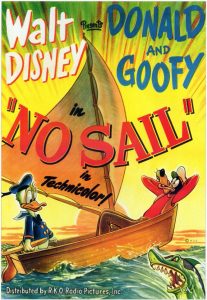 No Sail (Disney/RKO, Donald and Goofy, 9/7/45 – Jack Hannah, dir.) – The war having just ended, the shipping lanes were now safe to accommodate civilian passengers once again. Donald and Goofy use this long-awauted opportunity to plan a voyage – by way of an unusual conveyance – a coin-operated, U-rent sailboat. Drop a coin in the slot, and a mast and sail telescope from a central box, instantly propelling the ship into deep water. So far, so good – but not very far – as the ship has a very short timer on the rental time, and the mast folds up again and disappears. Donad drops in another coin, and with a sneezing sounf, the sail pops out again. Another zooming lurch into deeper ocean – then the sail folds up again. Running low on coin, Donald tries again – but the emerging mast boom bashes him on the head. Donald kicks at the boom, and it folds back into the box prematurely, a light on the box reading “Tilt”. Donald turns his pockets inside out – empty. The ship lies becalmed in the middle of the ocean, as the hot midday sun blazes. Time passes, and Donald proves that if a duck doesn’t shave in the morning, his bill will develop bristly stubble! The overheated duck calls for water. Goofy produces a glass (complete with ice cubes!) and scoops up a cupful from the ocean. “No no, don’t drink it”, shouts Donald. But superhuman Goof not only sips, but adds more salt to taste from a shaker, while a perplexed Donald looks on in wonderment. A low whistle reveals the approach of an ocean liner. Donald tries to hail it with his hat – and discovers to his surprise one last nickel had been hidden away inside. The nickel rolls along the rail of the boat as Donald gives chase – then plops into the ocean. By the time Doald turns around, the ocean liner is already passing, and Goofy has made no effort to have them stop to pick them up, instead merely giving friendly waves to the passengers.
No Sail (Disney/RKO, Donald and Goofy, 9/7/45 – Jack Hannah, dir.) – The war having just ended, the shipping lanes were now safe to accommodate civilian passengers once again. Donald and Goofy use this long-awauted opportunity to plan a voyage – by way of an unusual conveyance – a coin-operated, U-rent sailboat. Drop a coin in the slot, and a mast and sail telescope from a central box, instantly propelling the ship into deep water. So far, so good – but not very far – as the ship has a very short timer on the rental time, and the mast folds up again and disappears. Donad drops in another coin, and with a sneezing sounf, the sail pops out again. Another zooming lurch into deeper ocean – then the sail folds up again. Running low on coin, Donald tries again – but the emerging mast boom bashes him on the head. Donald kicks at the boom, and it folds back into the box prematurely, a light on the box reading “Tilt”. Donald turns his pockets inside out – empty. The ship lies becalmed in the middle of the ocean, as the hot midday sun blazes. Time passes, and Donald proves that if a duck doesn’t shave in the morning, his bill will develop bristly stubble! The overheated duck calls for water. Goofy produces a glass (complete with ice cubes!) and scoops up a cupful from the ocean. “No no, don’t drink it”, shouts Donald. But superhuman Goof not only sips, but adds more salt to taste from a shaker, while a perplexed Donald looks on in wonderment. A low whistle reveals the approach of an ocean liner. Donald tries to hail it with his hat – and discovers to his surprise one last nickel had been hidden away inside. The nickel rolls along the rail of the boat as Donald gives chase – then plops into the ocean. By the time Doald turns around, the ocean liner is already passing, and Goofy has made no effort to have them stop to pick them up, instead merely giving friendly waves to the passengers.
Weeks pass, as Donald keeps calendar with marks for each day on the ship’s stern. A flying fish fortuitously plops into the boat, but as Donald and Goofy argue over who gets to eat it, a passing seagull solves the problem by grabbing the fish from their hands. Our heroes take turns socking at the seagull with a club, each time it lands on the other’s head. Donald’s cranium winds up with several lumps, but in the case of Goofy, Donald’s club, not Goofy’s head, ends up with the lumps. A passing shark fin pokes at Donald’s tail. Goofy pulls at the shark fin – but finds it to be a floating fin only with nothing underneath. Of course, when Donald tries to lift it, it comes compete with shark. Goofy sees the creature as prospective food, and prepares a fishing line. Propelling the line’s hook in a wide circle for his cast, Goofy unknowingly hooks Donald, and casts him into the shark-infested waters. Donald struggles with multiple sharks below the surface, holding their jaws closed with his arm and feet, while tugging at the fishing line with his other hand to signal Goofy to reel him in. But Goofy is not getting the signal, as his line has unreeled off the spindle in a hopeless backlash. Goofy gets so confused in attempting to unravel it, he starts playing “cat’s cradle” with the line strewn around his fingers. Donald’s two sharks finally get things coordinated and swim together in the same direction, pulling the line out to its full extension and spinning Goofy like a top. Goof finally reels in a bedraggled Donald, inches shy of the sharks’ jaws. Donald demands to be put down, so Goofy drops him – and his bill lands straight into the boat’s coin slot, proving to be perfect fit. Goofy happily sails with the reemerging mast, while it appears Donald will make the whole voyage home balanced on his nose.
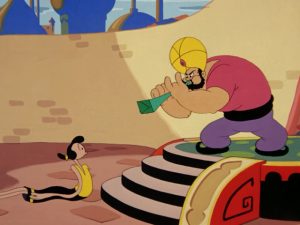 The Fistic Mystic (Paramount/Famous, Popeye, 11/29/46 – Seymour Kneitel, dir.) – In the tradition of “Mickey In Arabia” and its progeny, Popeye and Olive tour the exotic East by camelback, and enter the walled city of “Badgag”. A town crier emerges from a high minaret, to announce “End of the 8th Inning – Giants 7, Brooklyn 3!” (So we know which way the staff’s betting money was riding.) In the bazaar, Bluto appears as a fakir, performing feats of magic. He stuffs links of sausage into one hand, recites magic words (actually on pig-latin), and produces a live pig. Olive is impressed: “A salami swami!” Bluro produces a snake charmer’s flute, and briefly hypnotizes Olive to wriggle like a snake up to the stage, then brings her onto the stage by playing the last notes in jazz, using his turban as a mute. Introducing himself as the great Bushwa (with a Superman-style “B” tattooed on his chest), Bluto promises Olive riches and love, transforming her clothes into a harem outfit with the passing of a hoop. He lays a kiss on her, and melts her into a yellow flowing mass down the stage stairs. “I’m just butter in his hands.” Popeye spots where Olive has wandered, but while trying to get her to come to her senses , he is hit by one of Bluto’s spells, and his face transforms into the shape of a jackass. Bluto demonstrates his lying on a bed of nails stunt, floating gently down atop them. Popeye tries a different approach, diving onto them and bending them into bedsprings. Bluto charms a cobra with his flute, but tooting through Popeye’s pipe makes the snake dance a hornpipe.
The Fistic Mystic (Paramount/Famous, Popeye, 11/29/46 – Seymour Kneitel, dir.) – In the tradition of “Mickey In Arabia” and its progeny, Popeye and Olive tour the exotic East by camelback, and enter the walled city of “Badgag”. A town crier emerges from a high minaret, to announce “End of the 8th Inning – Giants 7, Brooklyn 3!” (So we know which way the staff’s betting money was riding.) In the bazaar, Bluto appears as a fakir, performing feats of magic. He stuffs links of sausage into one hand, recites magic words (actually on pig-latin), and produces a live pig. Olive is impressed: “A salami swami!” Bluro produces a snake charmer’s flute, and briefly hypnotizes Olive to wriggle like a snake up to the stage, then brings her onto the stage by playing the last notes in jazz, using his turban as a mute. Introducing himself as the great Bushwa (with a Superman-style “B” tattooed on his chest), Bluto promises Olive riches and love, transforming her clothes into a harem outfit with the passing of a hoop. He lays a kiss on her, and melts her into a yellow flowing mass down the stage stairs. “I’m just butter in his hands.” Popeye spots where Olive has wandered, but while trying to get her to come to her senses , he is hit by one of Bluto’s spells, and his face transforms into the shape of a jackass. Bluto demonstrates his lying on a bed of nails stunt, floating gently down atop them. Popeye tries a different approach, diving onto them and bending them into bedsprings. Bluto charms a cobra with his flute, but tooting through Popeye’s pipe makes the snake dance a hornpipe.
Bluto has had it with the competition, and hits Popeye with a super whammy. Against the spell, Popeye reaches for his spinach, but an extra zap knocks the can from his hand, and transforms Popeye into a parrot, whom Bluto places into a cage. Olive protests, and Bluto says, “So, you want to get into the act.” He throws her into a wicker basket, and starts pushing swords through it. When he is finally about to plunge in a scimitar, Olive sprouts her legs out the basket bottom and runs for it, kicking up Popeye’s spinach can. She places the can on the bird cage in place of the feeder, and Popeye gets his fill, transforming back to human form. Bluto throws his scimitar at Popeye. Popeye in turn pulls one one of the few strands of hair on his head, and holds it out in the path of the approaching blade. It saws through the blade rather than the other way around, cutting the blade in two. Bluto uses the Indian rope trick and climbs into the skies with Olive, producing at the top a magic carpet for a getaway. Popeye grabs the lower end of the rope and bends it into the shape of a moving department-store escalator to ascend to the top. A wild battle takes place on the carpet, with Popeye and Olive doing circus acrobatic flips to get the jump on Bluto. Once more, Bluto tries a whammy: “You are now a canary bird.” But this time, Popeye socks the bolt back at Bluto, who is transformed into a “hairy canary”. Popeye and Olive sail back to the States aboard the flying carpet, and as they reach New York, Popeye cheers and rises with his arms outstretched and lips puckered. Olive expect a celebration kiss, but is surprised to see Popeye pass her and lay a smack upon the lips of the Statue of Liberty as they fly past. “I just loves that woman”, says Popeye for the fade-out (modified from catch phrase of the maid Beulah from radio’s “Fibber McGee and Molly”).
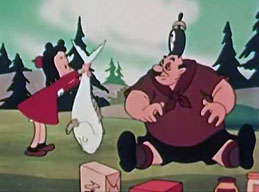 A Scout With the Gout (Paramount/Famous, Little Lulu, 3/24/47 – Bill Tytla, dir.) – A peaceful backyard snooze in a hammock for Mr. Moppet is interrupted by the floating by of smoke signal letters spelling “Lulu”. Papa Moppet accidentally inhales one of the words, and coughs it out in a flurry of smaller “Lu”s. Lulu is of course the source behind the garage, practicing in hopes of becoming a girl scout. Papa is impressed by her aspiration, and determines to take Lulu into a proper environment in the woods and teach her everything he knows. As the two march along into the forest, Lulu becomes hungry, and turns to her favorite food source – a stash of lollipops. Papa tells her a true scout forages for food in the woods, and tosses the candy away – where the stick falls into the hands or a raccoon. He funds the treat so tasty, he start to tail Lulu to seek out more. Papa pitches camp near a stream where the fish are so hungry, they bite if you even point a finger at the water. Lulu duplicates the scenario with a pointing signpost, to which she attaches a mousetrap to catch the nose of the springing fish. Papa tries to light a fire with two sticks, but Lulu gets quicker results with a good old match. She suddenly notices her fish is gone – the raccoon having moved on to bigger game than lollipops. Papa and Lulu set out to track the culprit. Tracks lead two ways, splitting Lulu and Papa – but converge on a cave. Lulu, on high ground, decides to pry a boulder loose to block up the cave entrance. Meanwhile Papa, on the low road, has just arrived at the cave’s mouth, and tosses in a burning log to smoke the thief out.
A Scout With the Gout (Paramount/Famous, Little Lulu, 3/24/47 – Bill Tytla, dir.) – A peaceful backyard snooze in a hammock for Mr. Moppet is interrupted by the floating by of smoke signal letters spelling “Lulu”. Papa Moppet accidentally inhales one of the words, and coughs it out in a flurry of smaller “Lu”s. Lulu is of course the source behind the garage, practicing in hopes of becoming a girl scout. Papa is impressed by her aspiration, and determines to take Lulu into a proper environment in the woods and teach her everything he knows. As the two march along into the forest, Lulu becomes hungry, and turns to her favorite food source – a stash of lollipops. Papa tells her a true scout forages for food in the woods, and tosses the candy away – where the stick falls into the hands or a raccoon. He funds the treat so tasty, he start to tail Lulu to seek out more. Papa pitches camp near a stream where the fish are so hungry, they bite if you even point a finger at the water. Lulu duplicates the scenario with a pointing signpost, to which she attaches a mousetrap to catch the nose of the springing fish. Papa tries to light a fire with two sticks, but Lulu gets quicker results with a good old match. She suddenly notices her fish is gone – the raccoon having moved on to bigger game than lollipops. Papa and Lulu set out to track the culprit. Tracks lead two ways, splitting Lulu and Papa – but converge on a cave. Lulu, on high ground, decides to pry a boulder loose to block up the cave entrance. Meanwhile Papa, on the low road, has just arrived at the cave’s mouth, and tosses in a burning log to smoke the thief out.
Down the hill rolls Lulu’s boulder, knocking Papa into the cave and trapping him inside. The raccoon appears, and tosses the burning log onto the seat of Papa’s pants to rouse him. Papa, discovering he’s trapped, yells for help in panic. The raccoon smacks him across the face with the fish, and shouts gibberish at him, ending with the words, “In other words, get a grip on yourself!” Lulu climbs to a rocky ledge above the cave, where she can hear Daddy through cracks in he cave roof . The fire from the log has spread to the cave floor, and flames literally “lick” at Papa, who briefly transforms into the shape of a smoked ham. “Water”, he shouts. No sooner said than done, as Lulu reroutes the flow of a waterfall with a hollow tree trunk, straight into the cave’s cracked roof. Papa is submerged under the massive flow, and as a new fish dives in the river water, the raccoon pursues it, grabbing its tail and pulling it out from the water. Unfortunately, the fish had caught in Papa’s mouth below the surface, and removing it causes the cave full of water to be swallowed by Papa, who bloats to fill the cave with his sloshing, rubbery movements. Lulu lowers a rope noose tied to a springy sapling, releases the tied-down tree, and yanks Papa out through the small roof crack, forcing all the water out of him and leaving him dangling from the tree top. The final scene has Lulu marching home to a jaunty camping song, with the raccoon in her knapsack finishing the last of her lollipops and starting in on another fish hooked to Lulu’s fishing pole. Bringing up the rear is Papa – on crutches, as Lulu sings of marching him “straight home to the doctor.”
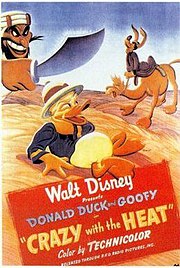 Crazy With the Heat (Disney/RKO, Donald and Goofy, 8/1/47 – Bob Carlson, dir.) – Donald and Goofy seem to have been becoming the go-to guys for travel adventures, somewhat in the style of Bob Hope and Bing Crosby in the “Road” pictures, wuth their last three pairings (also including “Frank Duck Brings ‘Em Back Alive” (1946)) each involving a considerable amount of globetrotting. However, this would be their last pairing together as a duo. It is curious that this would be the only known director credit for Bob Carlson on a short (Carlson normally devoting his time to the feature division). How he got the project rather than one of Disney’s directing regulars is unknown – yet, there were other similar strange things going on in the director’s chairs at the studio for a short time. Jack Kinney had been shunted over to the feature division, including for work on “Mr. Toad”, leaving Jack Hannah to briefly assume his chair for several episodes of the Goofy series in addition to his regular split of Donald Duck duties with Jack King. Clyde Geronimi would fall back into the shorts department for one film to bail out Hannah, on Goofy’s “The Big Wash”. So it can only be surmised that Hannah, shouldering an ever increasing share of the Donald load, was being overworked in Kinney’s absence, and just couldn’t assume this extra project, despite his successful helming of the duo’s last two appearances together. While Carlson presumably tries his best, this production is unusually short, barely exceeding six minutes, suggesting for a Disney product that it was turned out in a comparative hurry. Its ending also falls rather flat – possibly the reason Carlson never received a return engagement in the shorts department.
Crazy With the Heat (Disney/RKO, Donald and Goofy, 8/1/47 – Bob Carlson, dir.) – Donald and Goofy seem to have been becoming the go-to guys for travel adventures, somewhat in the style of Bob Hope and Bing Crosby in the “Road” pictures, wuth their last three pairings (also including “Frank Duck Brings ‘Em Back Alive” (1946)) each involving a considerable amount of globetrotting. However, this would be their last pairing together as a duo. It is curious that this would be the only known director credit for Bob Carlson on a short (Carlson normally devoting his time to the feature division). How he got the project rather than one of Disney’s directing regulars is unknown – yet, there were other similar strange things going on in the director’s chairs at the studio for a short time. Jack Kinney had been shunted over to the feature division, including for work on “Mr. Toad”, leaving Jack Hannah to briefly assume his chair for several episodes of the Goofy series in addition to his regular split of Donald Duck duties with Jack King. Clyde Geronimi would fall back into the shorts department for one film to bail out Hannah, on Goofy’s “The Big Wash”. So it can only be surmised that Hannah, shouldering an ever increasing share of the Donald load, was being overworked in Kinney’s absence, and just couldn’t assume this extra project, despite his successful helming of the duo’s last two appearances together. While Carlson presumably tries his best, this production is unusually short, barely exceeding six minutes, suggesting for a Disney product that it was turned out in a comparative hurry. Its ending also falls rather flat – possibly the reason Carlson never received a return engagement in the shorts department.
Once again, our starring heroes find themselves lost – though in the opposite environment of their previous excursion at sea. Here, their jalopy (windshield plastered with travel stickers of the type usually seen on steamer trunks) breaks down in the middle of a Middle-Eastern desert. After virtually dismantling the car, Goofy diagnoses the situation – “She’s just outta gas.” He sets off across the sands in a hopeless quest to “get a few gallons”, with frustrated Donald tagging along. As the baking sun beams down upon them, Goofy reaches for his canteen, and starts gulping down the whole works. Donald gabs the canteen away, capping it. “You gotta ration it”, he warns Goofy, reminding him that they’re lost. Goofy insists that he’s never lost, because he carries a map. He does indeed – a micro-scale “Map of the World”. As Donald watches in helpless disbelief, Goofy tries to read this nearly useless guide in the only way he can – under a large magnifying glass. Glass plus sunlight equals – FIRE!, as the map ignites into flames. In a panic, Goofy grabs back the canteen, poring out its contents to put out the blaze. Donald goes into hysterics, and on inspecting the canteen, finds left only one drop – which falls into the sand. Donald becomes a human mole, frantically digging an endless hole in a futile attempt to catch up with that last remaining moisture.
 Nonchalant Goofy leaves Donald to his new pastime, and decides to have a look around. He encounters a fade-in image of a surprisingly welcome sight – the “Oasis Soda Fountain”. “Guess I’ll go in and wet my whistle”, saud Goofy. He is greeted by a large, seemingly jovial, but transparent Sheik. Goof orders a double ice cream soda, which is slid to him on the bar, complete with cherry on top. Goof tosses the cherry in the air to catch in his mouth. But the cherry never lands, as glass, bar, and barstool all disappear. “It’s gone!”, says Goofy. “So it is” says the Sheik’s voice, as the bar fades in again. “Woulds’t have another?” Another drink materializes on the bar. Goofy gets the glass in his hand, only to have everything disappear again. “Hey”, says Goofy, opening the fingers of his empty hand wide. “Four more?” says the Sheik’s voice, counting his fingers. “Thou art indeed thirsty!” Four more glasses slide down the reappearing bar. Goofy plays it cool, ignoring the drinks, then suddenly leaping on them, but falls right through the vanishing bar onto his face. As he rises, he hits his head on the reappearing bar counter. “Somethin’ wrong here. I’m gettin’ outta this clip joint”, says our hero. But the Shiek insists on the small matter of a fee – six bucks. “I won’t pay it”, said Goof. Suddenly a tall stack of dirty plates, cups and saucers materializes in Goofy’s hands, and the Sheik reappears carrying a scimitar. “Thou shalt not break any, now shalt thou?”, he warns.
Nonchalant Goofy leaves Donald to his new pastime, and decides to have a look around. He encounters a fade-in image of a surprisingly welcome sight – the “Oasis Soda Fountain”. “Guess I’ll go in and wet my whistle”, saud Goofy. He is greeted by a large, seemingly jovial, but transparent Sheik. Goof orders a double ice cream soda, which is slid to him on the bar, complete with cherry on top. Goof tosses the cherry in the air to catch in his mouth. But the cherry never lands, as glass, bar, and barstool all disappear. “It’s gone!”, says Goofy. “So it is” says the Sheik’s voice, as the bar fades in again. “Woulds’t have another?” Another drink materializes on the bar. Goofy gets the glass in his hand, only to have everything disappear again. “Hey”, says Goofy, opening the fingers of his empty hand wide. “Four more?” says the Sheik’s voice, counting his fingers. “Thou art indeed thirsty!” Four more glasses slide down the reappearing bar. Goofy plays it cool, ignoring the drinks, then suddenly leaping on them, but falls right through the vanishing bar onto his face. As he rises, he hits his head on the reappearing bar counter. “Somethin’ wrong here. I’m gettin’ outta this clip joint”, says our hero. But the Shiek insists on the small matter of a fee – six bucks. “I won’t pay it”, said Goof. Suddenly a tall stack of dirty plates, cups and saucers materializes in Goofy’s hands, and the Sheik reappears carrying a scimitar. “Thou shalt not break any, now shalt thou?”, he warns.
Back at the sands, Donald has dug himself halfway to China – but no water. Now the desert madness starts to get to him, as he envisions – icebergs! Of course, each one turns out to be a sand dune, a palm tree, and the last one Goofy with the dishes. (By the way, with no water for miles, what did the Sheik expect Goofy to wash the dishes in?) Donald collides with Goofy, and the dishes go flying, landing in a cracked heap around them. “Tis done” says the Sheik, fading in again. “Off comes thy head!” He swipes furiously at our heroes, barely missing Goofy, but connecting with Donald’s hat, cutting the top off it, then swinging a fist blow that gives Donald a black eye. “Look out, Donald”, says Goofy, “Duck!” But of course, Donald takes it on the chin again. But the writers seem to get stuck for an ending, and merely have our heroes run, the Sheik disappearing from the action except for his voice yelling “Stop”, and the boys finding a convenient camel at an oasis and mounting up for a getaway, Goofy shouting, “We’re saved.” Just too pat – with no punch line whatsoever. How did this plot hole pass Disney’s keen eye – or was he looking the other way at some feature project, and missed the story session entirely? I guess what can one expect from substitute help.
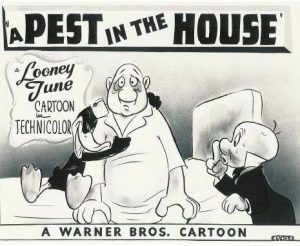 A Pest In the House (Warner, Daffy Duck, 8/2/47 – Charles M. (Chuck) Jones, dir.) – a neglected and frequently overlooked title that deserves more recognition as a certifiable classic. An examination of hotel life as a respite from the stressful world – with just one loose end. A labor shortage is on, causing the industry to hire anybody – or any thing! That “thing” is Daffy Duck, new bellboy at the Gland Hotel, managed by Elmer Fudd. A large stocky fellow arrives as new guest, and reminds Elmer that he is there for peace and quiet, and plenty of sleep. His otherwise mild mannered voice (provided by radio and film veteran Arthur Q. Bryan (also the voice of Elmer Fudd, so he gets to talk to himself!) in his normal speaking tone – a voice used on radio as “Doc Gamble” on Fibber McGee and Molly) increases to an enraged shout, as he adds “If I’m disturbed at any time, I’m gonna bust you right in the nose!” Mel Blanc also has a field day in this cartoon, providing Daffy with one of his most irascible reads ever, as the bellboy from hell. As the man asks to be taken to his room, Daffy, instead of carrying up the gentleman’s luggage, begins piling it to the skies in the man’s own arms, letting him strain under the weight as Daffy takes him up in the elevator, all the while keeping up a non-stop chatter almost at the top of his lungs about how the place is “slopping over with peace and quiet.” He continues to let the exhausted man sweat, while Daffy takes forever attempting to locate the key to enter his room on a massive key ring – then, when the key is finally located, merely pushes open the room’s door, which was unlocked anyway! “Just drop ‘em any old where”, Daffy tells the man, who finally lets go of the suitcases – and Daffy hands the customer a tip! The man is so confused, he walks out of the room, thinking himself the bellboy – then stops, as blood fills the veins in his eyes to a glowing red. Back in the room, Daffy is now trying on the man’s hats. “P,U. Never come back in style, never.” As the man is about to commit murder, he sights the bed, and makes a bee-line under the covers, asleep and snoring in a split second. Daffy tiptoes outside – then disrupts the entire scene by noisily tacking up a “Do Not Disturb” sign on the door with a hammer – and continuing to hammer on the man’s head when he opens the door. In the running gag of the film, the man slowly trudges to the elevator, descends to the lobby, and socks Elmer in the face across the lobby desk.
A Pest In the House (Warner, Daffy Duck, 8/2/47 – Charles M. (Chuck) Jones, dir.) – a neglected and frequently overlooked title that deserves more recognition as a certifiable classic. An examination of hotel life as a respite from the stressful world – with just one loose end. A labor shortage is on, causing the industry to hire anybody – or any thing! That “thing” is Daffy Duck, new bellboy at the Gland Hotel, managed by Elmer Fudd. A large stocky fellow arrives as new guest, and reminds Elmer that he is there for peace and quiet, and plenty of sleep. His otherwise mild mannered voice (provided by radio and film veteran Arthur Q. Bryan (also the voice of Elmer Fudd, so he gets to talk to himself!) in his normal speaking tone – a voice used on radio as “Doc Gamble” on Fibber McGee and Molly) increases to an enraged shout, as he adds “If I’m disturbed at any time, I’m gonna bust you right in the nose!” Mel Blanc also has a field day in this cartoon, providing Daffy with one of his most irascible reads ever, as the bellboy from hell. As the man asks to be taken to his room, Daffy, instead of carrying up the gentleman’s luggage, begins piling it to the skies in the man’s own arms, letting him strain under the weight as Daffy takes him up in the elevator, all the while keeping up a non-stop chatter almost at the top of his lungs about how the place is “slopping over with peace and quiet.” He continues to let the exhausted man sweat, while Daffy takes forever attempting to locate the key to enter his room on a massive key ring – then, when the key is finally located, merely pushes open the room’s door, which was unlocked anyway! “Just drop ‘em any old where”, Daffy tells the man, who finally lets go of the suitcases – and Daffy hands the customer a tip! The man is so confused, he walks out of the room, thinking himself the bellboy – then stops, as blood fills the veins in his eyes to a glowing red. Back in the room, Daffy is now trying on the man’s hats. “P,U. Never come back in style, never.” As the man is about to commit murder, he sights the bed, and makes a bee-line under the covers, asleep and snoring in a split second. Daffy tiptoes outside – then disrupts the entire scene by noisily tacking up a “Do Not Disturb” sign on the door with a hammer – and continuing to hammer on the man’s head when he opens the door. In the running gag of the film, the man slowly trudges to the elevator, descends to the lobby, and socks Elmer in the face across the lobby desk.
Sequence two finds Daffy re-entering to check up on the customer. Findng the room stuffy, he opens the window – letting in raucous city noises louder than those that disturbed Betty Boop in Stop That Noise. The racket scares the man right out of bed, leaving him hanging from the light fixture. He doesn’t blow up immediately, but closes the window. Then, from an adjoining room, he hears the drunken singing of a neighbor, in a chorus of “How Dry I Am.” Daffy’s head appears at the doorway. “Don’t stir yourself, sir. I’ll muzzle that inebriated canary.” A moment later, the singing stops – jus long enough to hear a bottle open, the gulping dwn of a drink, and the second voice of Daffy join in the song. Back to the lobby for the man, and another punch for Elmer.
Third interruption has Daffy washing the room window. He is obsessed with removing a “speck”, and scrapes at the glass with his fingernail, producing the incessantly irritating sound of chalk on a blackboard. This time, the man doesn’t even walk downstairs, but telephones the front desk, his fist punching Elmer through the receiver.
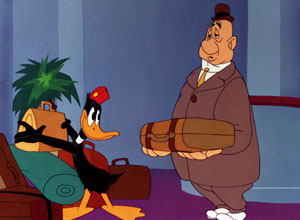 Sequence four has Daffy told by an unseen member of the staff “the funniest story I’ve heard in years” – a “traveling salesman” joke. In a riotous read by Mel Blanc, Daffy deems the story “too good to keep”, and wakes the man up to repeat it to him. Daffy takes forever to relate the yarn, breaking himself up with fits of laughter, while the exhausted man sits in a catatonic state. Finally, the man descends to the lobby again. Elmer tries to defend by donning an iron knight’s helmet, but the man merely lifts his visor, and socks him anyway. When the man returns upstairs, Daffy has still not finished the story, and to make the whole affair even more unnecessary, forgets entirely the story’s punch line!
Sequence four has Daffy told by an unseen member of the staff “the funniest story I’ve heard in years” – a “traveling salesman” joke. In a riotous read by Mel Blanc, Daffy deems the story “too good to keep”, and wakes the man up to repeat it to him. Daffy takes forever to relate the yarn, breaking himself up with fits of laughter, while the exhausted man sits in a catatonic state. Finally, the man descends to the lobby again. Elmer tries to defend by donning an iron knight’s helmet, but the man merely lifts his visor, and socks him anyway. When the man returns upstairs, Daffy has still not finished the story, and to make the whole affair even more unnecessary, forgets entirely the story’s punch line!
In the final sequence, Daffy thinks the man’s room is not receiving enough heat, and goes to the basement to “repair” the radiator. Elmer spots him going downstairs, and anticipates trouble. He races to catch the screwball duck, only to reach the basement as Daffy whams the radiator pipe with a sledge hammer. The vibration clangs through the pipes, and Elmer races up several flights of stairs to beat the clang to the man’s room. He enters and places pillows all around the radiator, then sits upon them, muffling the clang to a dull ping. But the crowning blow follows – the steam vent of the radiator lets out a small whistle – enough to wake the man. To ensure another incident, Daffy launches into a verbal tirade at Elmer, accusing him of “blowing whistles” while he works himself to the bone to ensure the man’s peace and quiet. The man rises from the bed toward Elmer, again appearing ready to commit homicide. Elmer descends to the lobby, and rings the desk bell. Daffy responds, and Elmer decrees, “For vewwy mewitorious service you are hereby pwomoted to the position of manager. Take over.” Elmer switches with Daffy, and dons the bellboy hat. In walks the man, rears back his fist as if to sock the new manager, but delivers a right cross instead that decks Elmer. Daffy closes the film with the observation, “Noisy little character, isn’t he?”
Thanks to J.B. Kaufman for the info about Paul Smith and his score for Pluto and the Armadillo
Next Week: Bugs makes his first wrong turn at Albuquerque.


 Charles Gardner is an animation enthusiast who toils by day as a member of LA Law – but by nights and weekends indulges in classic jazz and ragtime as a performer; and studies classic Hollywood cartoons… maybe a little too much.
Charles Gardner is an animation enthusiast who toils by day as a member of LA Law – but by nights and weekends indulges in classic jazz and ragtime as a performer; and studies classic Hollywood cartoons… maybe a little too much.


































































































































































“Oh, my darling armadillo, let me tell you of my love!
Listen to my armadillo roundelay!
Be my fellow on my pillow,
Underneath this weeping willow!
Be my darling armadillo all the day!” — Michael Flanders
Loved this week’s cartoons, at least half of which were new to me, including one about one of my favourite mammals (or rather, orders of mammals)! The species of armadillo that can roll up into a ball is the Three-banded armadillo, which does indeed live in northeastern Brazil (although Belem is a bit out of its range). Contrary to what the narrator says, it is not a member of the family Dasypodidae but of the other extant family in the order Cingulata, the Chlamyphoridae. Yes, I know I’m picking the most minuscule of nits here; but as long as they took the trouble to look up the scientific name for a family of armadillos, given that there are only two of them, they at least could have picked the right one.
I’m sure the Disney artists saw plenty of armadillo-shell baskets hanging in the market stalls while on their South American goodwill tour, but of course armadillos don’t really sleep in trees like that.
Incidentally, there’s a South American musical instrument called the charango, sort of like a ten-stringed ukulele, that was traditionally made using an armadillo shell as its resonating chamber. (I understand modern charangos have wooden bodies because of the increasing rarity of armadillos, and besides, it gives a better tone.) I knew an Argentinian violin dealer who had an armadillo-shell charango hanging in his shop, for display purposes only; its body was made from the Hairy armadillo, the most common species in Argentina, and it was actually pretty disgusting. I wonder if Paul Smith used one in his cartoon score.
I’ll have to find the sheet music to the “Armadillo Samba”; one can never know too many songs about armadillos! Now I’m going to watch “Pluto and the Armadillo” again. Thanks for an “armadillightful” post! Hasta luego en Albuquerque!
LOL! LOVE “A PEST IN THE HOUSE” (and sad, Daffy doesn’t really end the short the way he does here, in many Jones cartoons even then). BTW, it’s FUDD’s, NOT the businessman’s voice, that was used for Doc Gamble.
Yet another excellent and informative posting by Gardner. Here is a link to Barney Bear’s “Bah Wilderness.”
https://www.facebook.com/CartoonFilms1/videos/402685474024362/
Thanks for that – I added the link to the main post above.
I love this website so much! It is so just fun to be able to read about and then with just a ‘click’ to be able to watch the cartoons. The information you provide is beyond delightful and informative to me. I am a BIG comic strip fan. But I don’t think there is a better place for a person to get pure joy than there is from watching classic Looney Tunes. I guess I just love the classics because watching classic Mickey Mouse cartoons just make me smile…throw in Donald Duck and Goofy and it just doesn’t get much better.
The information you provide Mr. Beck, via Cartoon Research/Animation Scoop is just so much appreciated. Know that the sharing of your knowledge not only enriches others put also leaves so many readers smiling!!
Thank you, Cynthia!
“…with no water for miles, what did the Sheik expect Goofy to wash the dishes in?”
You can wash dishes with sand. I had to do it on a camping trip once. If you have a rag to wipe the sand off, you can actually get the dishes pretty clean.